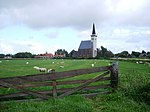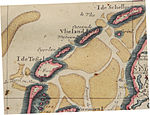De Koog
Populated places in North HollandSeaside resorts in the NetherlandsTexel

De Koog is a village in the Dutch province of North Holland. It is a part of the municipality of Texel, and lies about 17 km north of Den Helder. It is the chief centre of tourism on the island, surrounded with many hotels and campgrounds. The village is located on the North Sea coast of the island. Only two narrow lines of dunes separate the village from the beach. South of the village is a wooded area which is also popular with tourists. The information centre and museum about the Wadden Sea, Ecomare, are located here.
Excerpt from the Wikipedia article De Koog (License: CC BY-SA 3.0, Authors, Images).De Koog
Dorpsstraat, Texel
Geographical coordinates (GPS) Address Nearby Places Show on map
Geographical coordinates (GPS)
| Latitude | Longitude |
|---|---|
| N 53.097777777778 ° | E 4.7627777777778 ° |
Address
Peter jouw kapper
Dorpsstraat 141
1796 CB Texel
North Holland, Netherlands
Open on Google Maps








